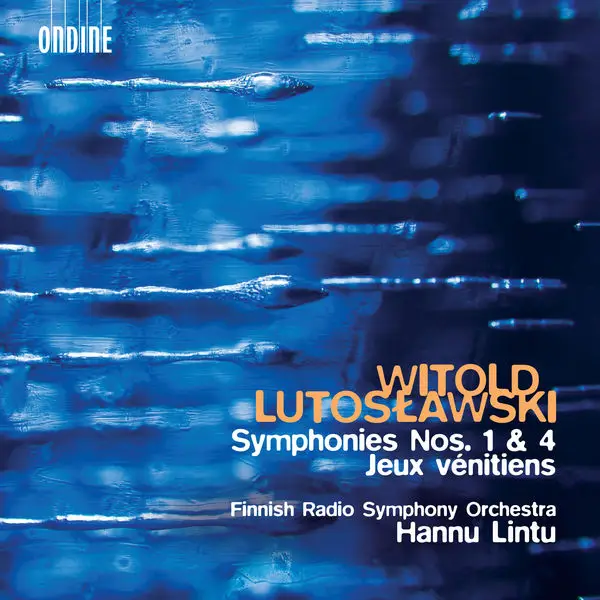The Finnish Radio Symphony Orchestra & Hannu Lintu - Lutosławski: Symphonies Nos. 1 and 4 & Jeux vénitiens (2018)
WEB FLAC (tracks) - 245 Mb | MP3 CBR 320 kbps - 132 Mb | Digital booklet | 00:57:22
Classical | Label: Ondine
WEB FLAC (tracks) - 245 Mb | MP3 CBR 320 kbps - 132 Mb | Digital booklet | 00:57:22
Classical | Label: Ondine
Witold Lutoslawski (1913-1994) is one of 20th Century’s greatest composers. He is also a remarkable symphonist. The three works on the present disc performed by the Finnish Radio Symphony Orchestra and conducted by Hannu Lintu, represent three important stages in Lutoslawski’s career: his 1st Symphony, one of his earliest significant works; Jeux vénitienswas the first work in his best-known stylistic phase; and his 4th Symphony remained his last extensive work.Tracklist:
Lutoslawski began his First Symphony in difficult times, during the Nazi occupation of Poland. At the time, he was making a living playing piano duos with composer colleague Andrzej Panufnik in the cafés of Warsaw. Lutoslawski made a start on the Symphony in 1941, but it was not until 1947 that he completed it. It is firmly rooted in Neo-Classicism but has none of the irony or stylisation commonly associated with that style. Also, it makes no use of folk music elements, which frequently appear in many of Lutoslawski’s post-war works. The work has an affinity with Bartók, Stravinsky and Prokofiev, and Lutoslawski himself mentioned Albert Roussel as one of his early influences. The sombre ethos and intense dramaturgy of the work have often been taken to reflect the worldwide conflict that was raging at the time of its genesis. Lutoslawski himself, however, rejected the connection; he emphasised that his music was absolute music that, as far as he was concerned, was independent of any direct links to the external world.
Inspired by John Cage, the composer began to develop a new technique of his own. The resulting ‘controlled aleatorism’ was first put into practice in the chamber orchestra work Jeux vénitiens (1960–1961). The title of Jeux vénitiens alludes to the fact that the work was meant to be premiered at the Venice Biennale. In the end, only three movements were performed there in April 1961, and the final four-movement version of the work was premiered in Warsaw in September in the same year. Secondarily, the title alludes to the game-like nature of its aleatoric writing. Each of the four movements of Jeux vénitiens has a definite character of its own. Taken together, they constitute a “psychological approach” to musical form that was favoured by Lutoslawski’s composition teacher Witold Maliszewski. According to his terminology, the structure of a work consisted of introductory, narrative, transitional and concluding sections.
The Fourth Symphony is a product of Lutoslawski’s late period at its most refined, characterised by a more nuanced and translucent harmonic approach than before, greater rhythmic clarity, a more straightforward approach and an expanded role for expressive melodic writing. These features stemmed in part from the fact that the importance of aleatoric sections was decreasing. In the Fourth Symphony, aleatoric counterpoint only accounts for about one fifth of the duration of the work. In his Third Symphony, Lutoslawski had created one of his most profound and manyfaceted works. By comparison, the Fourth was more restrained and serene; the composer himself said as much by noting that “my Fourth after my Third is a little bit like Beethoven’s Fourth after Eroica”. Written in 1988–92, it also remained his last extensive work; he conducted its premiere in Los Angeles in February 1993, one year before his death.
1. Symphony No. 1: I. Allegro giusto
2. Symphony No. 1: II. Poco adagio
3. Symphony No. 1: III. Allegretto misterioso
4. Symphony No. 1: IV. Allegro vivace
5. Jeux vénitiens, Pt. 1
6. Jeux vénitiens, Pt. 2
7. Jeux vénitiens, Pt. 3
8. Jeux vénitiens, Pt. 4
9. Symphony No. 4
–––––––––––-
DON'T MODIFY THIS FILE
–––––––––––-
PERFORMER: auCDtect Task Manager, ver. 1.6.0 RC1 build 1.6.0.1
Copyright © 2008-2010 y-soft. All rights reserved
ANALYZER: auCDtect: CD records authenticity detector, version 0.8.2
Copyright © 2004 Oleg Berngardt. All rights reserved.
Copyright © 2004 Alexander Djourik. All rights reserved.
FILE: 9 Symphony No. 4.flac
Size: 88847671 Hash: E139AEE9CC200AF7BFD276D1829A2BD6 Accuracy: -m0
Conclusion: CDDA 100%
Signature: 615940F5655E18B879C95A22A5CB198131666686
FILE: 8 Jeux vénitiens, Pt. 4.flac
Size: 20567752 Hash: 58965DCC1AC9018148314AD0CBA4EC9E Accuracy: -m0
Conclusion: CDDA 100%
Signature: FC81FEE674F9D287BF3C8A86E5B5D571DB37FC28
FILE: 7 Jeux vénitiens, Pt. 3.flac
Size: 11482979 Hash: 3EDC8F53201ABFCFA6A3AB30349D73DA Accuracy: -m0
Conclusion: CDDA 100%
Signature: 1FB20659D9EFAC8C28AE095393BF196F0EFD76B7
FILE: 6 Jeux vénitiens, Pt. 2.flac
Size: 6776176 Hash: ADCE15C740D2F14894BB8958261B62D5 Accuracy: -m0
Conclusion: CDDA 100%
Signature: 301E73B52212DBF5CA22254EAC44178B508A4D70
FILE: 5 Jeux vénitiens, Pt. 1.flac
Size: 8934906 Hash: 11C033D068260D01E0E8442BF7121EAA Accuracy: -m0
Conclusion: CDDA 100%
Signature: A2B935643673FC22A3A609A4BD0DE647ABC8C76D
FILE: 4 Symphony No. 1- IV. Allegro vivace.flac
Size: 28245093 Hash: 0F34E23BB2D26EF7ACFB31ADFFF99450 Accuracy: -m0
Conclusion: CDDA 100%
Signature: 7F9640AB9C478F14334103E4D3B8D177D15B6E9C
FILE: 3 Symphony No. 1- III. Allegretto misterioso.flac
Size: 20422327 Hash: FC807B3058B7B5625E633CA5CFAC528E Accuracy: -m0
Conclusion: CDDA 100%
Signature: 18AD6D8DA73896DFD3CC6157F624F91DB64DA59D
FILE: 2 Symphony No. 1- II. Poco adagio.flac
Size: 43900815 Hash: 32D3D5C3C67DED2DBDE0E8CCBD5D3EBD Accuracy: -m0
Conclusion: CDDA 100%
Signature: C496613CF8AF9B04B79D63478AAD4D021C71C8F1
FILE: 1 Symphony No. 1- I. Allegro giusto.flac
Size: 27558091 Hash: 59A26364B8F5752124C678A9AC2537A5 Accuracy: -m0
Conclusion: CDDA 100%
Signature: 91E5BB239FA18E35AF67DEC6596E4A2BC9BB8A9C
DON'T MODIFY THIS FILE
–––––––––––-
PERFORMER: auCDtect Task Manager, ver. 1.6.0 RC1 build 1.6.0.1
Copyright © 2008-2010 y-soft. All rights reserved
ANALYZER: auCDtect: CD records authenticity detector, version 0.8.2
Copyright © 2004 Oleg Berngardt. All rights reserved.
Copyright © 2004 Alexander Djourik. All rights reserved.
FILE: 9 Symphony No. 4.flac
Size: 88847671 Hash: E139AEE9CC200AF7BFD276D1829A2BD6 Accuracy: -m0
Conclusion: CDDA 100%
Signature: 615940F5655E18B879C95A22A5CB198131666686
FILE: 8 Jeux vénitiens, Pt. 4.flac
Size: 20567752 Hash: 58965DCC1AC9018148314AD0CBA4EC9E Accuracy: -m0
Conclusion: CDDA 100%
Signature: FC81FEE674F9D287BF3C8A86E5B5D571DB37FC28
FILE: 7 Jeux vénitiens, Pt. 3.flac
Size: 11482979 Hash: 3EDC8F53201ABFCFA6A3AB30349D73DA Accuracy: -m0
Conclusion: CDDA 100%
Signature: 1FB20659D9EFAC8C28AE095393BF196F0EFD76B7
FILE: 6 Jeux vénitiens, Pt. 2.flac
Size: 6776176 Hash: ADCE15C740D2F14894BB8958261B62D5 Accuracy: -m0
Conclusion: CDDA 100%
Signature: 301E73B52212DBF5CA22254EAC44178B508A4D70
FILE: 5 Jeux vénitiens, Pt. 1.flac
Size: 8934906 Hash: 11C033D068260D01E0E8442BF7121EAA Accuracy: -m0
Conclusion: CDDA 100%
Signature: A2B935643673FC22A3A609A4BD0DE647ABC8C76D
FILE: 4 Symphony No. 1- IV. Allegro vivace.flac
Size: 28245093 Hash: 0F34E23BB2D26EF7ACFB31ADFFF99450 Accuracy: -m0
Conclusion: CDDA 100%
Signature: 7F9640AB9C478F14334103E4D3B8D177D15B6E9C
FILE: 3 Symphony No. 1- III. Allegretto misterioso.flac
Size: 20422327 Hash: FC807B3058B7B5625E633CA5CFAC528E Accuracy: -m0
Conclusion: CDDA 100%
Signature: 18AD6D8DA73896DFD3CC6157F624F91DB64DA59D
FILE: 2 Symphony No. 1- II. Poco adagio.flac
Size: 43900815 Hash: 32D3D5C3C67DED2DBDE0E8CCBD5D3EBD Accuracy: -m0
Conclusion: CDDA 100%
Signature: C496613CF8AF9B04B79D63478AAD4D021C71C8F1
FILE: 1 Symphony No. 1- I. Allegro giusto.flac
Size: 27558091 Hash: 59A26364B8F5752124C678A9AC2537A5 Accuracy: -m0
Conclusion: CDDA 100%
Signature: 91E5BB239FA18E35AF67DEC6596E4A2BC9BB8A9C



